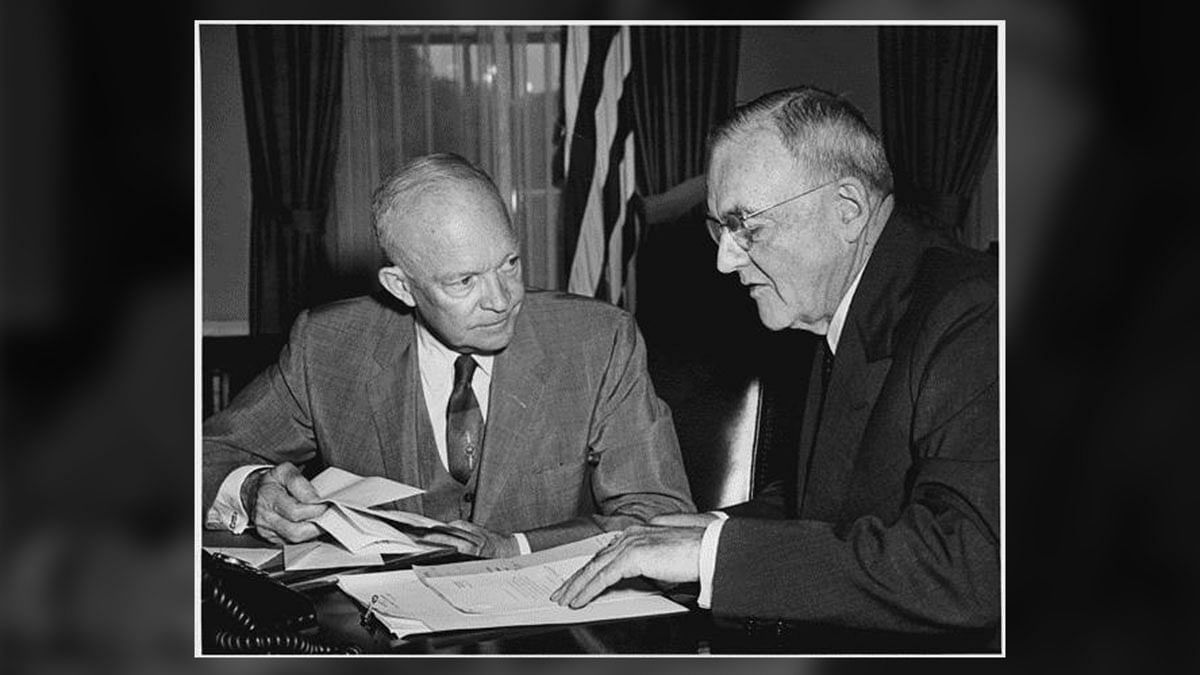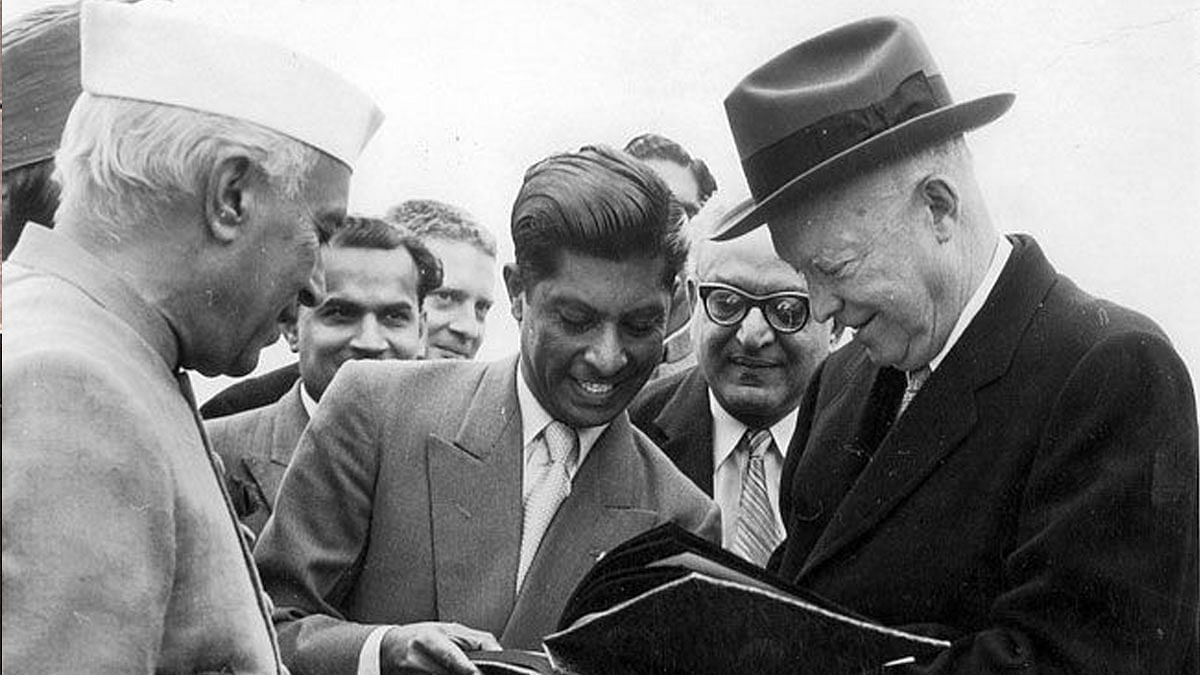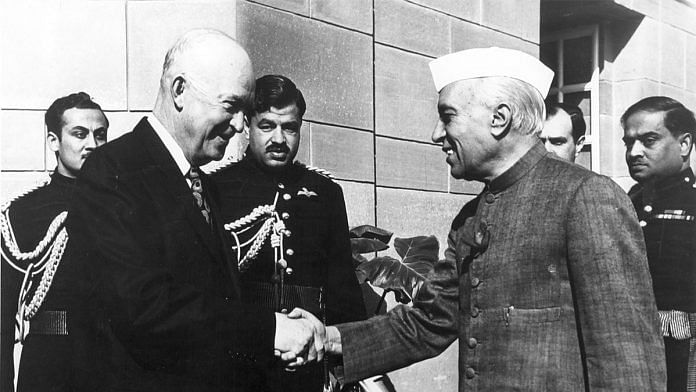New Delhi: The bonhomie between Prime Minister Narendra Modi and US President Donald Trump has been making headlines since they met on the sidelines of the G7 Summit in France last month.
During that meeting, the two leaders laughed, talked, joked — clearly showing the world that they have built a rapport. Modi had even playfully slapped Trump’s hand, taking social media by storm.
The camaraderie was on full display again at the Howdy, Modi! event in Houston last Sunday, where the two leaders lavished praise on each other. Modi even went a step ahead and literally campaigned for the US President in his speech, chanting, “Abki bar, Trump sarkar (this time, Trump government)”.
However, this isn’t the first time when an Indian and an American leader have got along so well. In the 1950s and ’60s, US President Dwight D. Eisenhower and Indian PM Jawaharlal Nehru had displayed great camaraderie, going to farmhouses and taking joy rides aboard fighter planes together during their visits to each other’s countries.
Here’s a look at their friendship and how it was steered by deeply contentious issues such as the Kashmir dispute and the rise of China — still relevant to India-US ties.
Diplomacy with intimacy
Eisenhower’s administration had a soft spot for Nehru, specifically, because he was a democratic leader.
“Between the first largest democracy on earth: India and the second largest: America, lie ten thousand miles of ocean. But in our fundamental ideas and convictions about democracy we are close neighbours. We ought to be closer,” Eisenhower had said at the Ramlila grounds in New Delhi on his maiden visit to India in 1959.
However, there were concerns about who would occupy the PM’s position after Nehru.
“…Nehru and present governing team in India is perhaps as able and as Western-oriented…The team which follows Nehru will emerge from the generation which was educated during the non-cooperation movement and which has never experienced the contact and exposure to Western thought and norms which Nehru’s team did. This team is bound to be more Asia-for-Asian minded, more inclined to employ authoritarian methods…,” according to historical documents posted on the website of the US Department of State.
During his visit to the US in 1956, Nehru, his wife and his daughter Indira Gandhi, were accorded a warm reception.
Eisenhower, instead of impressing him with “the pomp and glitter of Washington”, took Nehru to his Gettysburg farm where they spoke “intimately for hours”, writes historian Andrew Jon Rotter in his book ‘Comrades at Odds: The United States and India, 1947-1964’.
Three years later, when Eisenhower came to India in 1959, he received a welcome so grand and magnificent that it had the American press “cabling rapturous pieces”.
Of all the US presidents during Nehru’s tenure as prime minister, he got along best with Eisenhower, said Sarvepalli Gopal, Nehru’s official biographer.
Nehru had little patience for Harry S. Truman’s “cocky vulgarity”, found John F. Kennedy “brash, aggressive and inexperienced” and he “hardly knew” Lyndon B. Johnson. He was most informal with Eisenhower and his Secretary of State John Foster Dulles.

In a telegram, Dulles wrote, “I had a most interesting, and I think rather significant two-day meeting in India. Most of the time I spent with Nehru. He had completely cleared his calendar for the two days of my visit.”
“The first day we had three and one-half hours together just the two of us, in a most intimate way. I was amused that toward the end of the conference he was sitting on the back of the sofa with his feet on the seat. We really took our hair down,” Dulles added.
Nehru also wanted to publicise their diplomatic correspondence, said Dulles.
Also read: This photo of Nehru and ‘India Gandhi’ backfires on Shashi Tharoor
Eisenhower offered to mediate on Kashmir
In an exchange of letters between Eisenhower and Nehru, the former had offered to mediate between India and Pakistan on the Kashmir issue, but Nehru declined saying, “…a settlement of our (India’s) various issues with Pakistan can only be arrived at satisfactorily by direct contacts between the two countries. If third parties intervene, even though that intervention proceeds from goodwill, the position becomes entirely different.”
Eisenhower’s America, on the other hand, was still recovering from the effects of World War II, and Hungarian refugees, who were kept at a temporary haven in Austria, was a major concern. Eisenhower wanted them out of Austria, but Nehru advised him to provide them aid.
They agreed on Chinese threat
India was aware of the Chinese threat to Nepal and Burma (now Myanmar) along India’s north and eastern border, and the US was concerned about it too.
In a correspondence with Dulles, Nehru said the situation reminded him of what the USSR did in China’s Yan’an, and that he feared Pakistan and China would connive against India.
Although Pakistan was a key US ally, Dulles, in a telegram to Eisenhower, emphasised on “assisting India in her unquestioned determination to build democratic counterpoise to Red China”.
“This posture coincides with internal economic crisis which unless resolved, could mean rapid erosion of India’s democratic forms and the faith of her present leaders, notably Nehru himself, that India can achieve a democratic Asian counterpoise to Red China without resort to authoritarian techniques which could progressively shift India into the Communist orbit… Nehru, therefore, comes to Washington in a sensitive position of weakness,” the US Department of State noted in its historical documents.

Sticky ties with Pakistan and the Soviet Union
In early 1948, India received little to no international support from the UN Security Council on the Kashmir issue and Nehru was afraid that US military aid to Pakistan would reduce India’s military superiority over Pakistan.
“Under the leadership of Prime Minister Nehru, Indian foreign policy continued to be independently oriented. Tension continued with Pakistan, India alleging that the United States was biased in favor of Pakistan with regard to the Kashmir issue because of Pakistan’s membership in the Baghdad Pact and SEATO,” according to the US state department historical documents.
In a telegram to Eisenhower, Dulles described India’s fear of Pakistan as “pathological”. He wrote, “Their fear is I think accentuated by somewhat of a guilty conscience in that they have themselves in effect taken over Kashmir by force and ignore the UN requirement of a plebiscite…”
The US, on the other hand, was worried about India’s growing closeness with the Soviet Union. In a telegram to Eisenhower, Dulles even red-flagged India’s plans to buy IL-28 type military planes from the USSR.
Also read: ‘Howdy, Modi!’ risks dividing the US on relations with India
Communism — the common enemy
Both Nehru and Eisenhower agreed that communism was a contagion with economic distress as its breeding ground.
“We had this terrible problem, how to keep our friends from acting aggressively, but yet not letting them go so far down the economic drain as a result of their impulsiveness that they become prey to Communist penetration!” Eisenhower said to Nehru during a conversation at the White House in December 1956.
“The President said that we in the United States recognise clearly that if all of Western Europe should fall to the Communists, then the Communists would have the power to proceed with their threats against the rest of the world. He said he is talking in the short-term military field. As the Prime Minister had indicated, in the long-term Communism really does defeat itself,” the US state department said.
Nehru pointed out that Russia was “probably counting on a few extra divisions…there in the satellite countries…”, which led Eisenhower to suggest setting aside an equal number of divisions to match the enemy’s.
At the end of their discussion, Eisenhower expressed his wish for the American people to overcome their adverse attitude towards Red China.
Eisenhower thought most of it was about “the ten (US) prisoners and the fact, as he had told Nehru the other day, of the casualties suffered in Korea”. This, coupled with the World War II aftermath, made for a battered American population that Eisenhower sought to uplift.
Nehru’s inputs on this issue left a lasting impression on Eisenhower. “He did not want to tell him (Nehru) how much he derived from this meeting — has gained much, he is sure, in understanding that will be helpful.”
Also read: Modi faces lawsuit in Houston, and there’s a Khalistani lawyer behind the complaint



